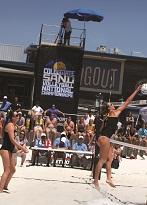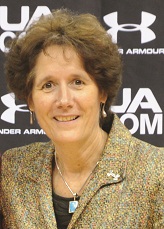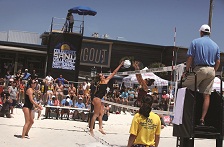

Our mission is to advance the sport of volleyball and its coaches through leadership, advocacy and professional development. We have 6,500 member coaches—about half are at the collegiate level, which means 80 percent of all U.S. college volleyball coaches belong to the AVCA. Our membership also consists of high school and youth club coaches. In the last six years, we’ve doubled our membership and also doubled participation by coaches in events we offer.
How has volleyball been doing in the U.S.?
Volleyball is a Title IX legacy sport—we had huge growth in the 1970s and ’80s, which firmly established the sport, especially for girls. Almost all U.S. high schools and colleges have female volleyball teams, and there are now more than 410,000 high school girls competing, which makes it the second highest for team sports behind girl’s basketball. The sport is growing on the boy’s side, too, but not as robust as with the girls. For collegiate women, there are now more than 1,500 volleyball programs. The latest research shows more than 2.6 million people play volleyball frequently, and 6.6 million, of all ages, play casually. It’s a very good time for our sport.
What is the AVCA’s relationship with USA Volleyball?
As the national governing body, USA Volleyball is an important strategic partner. They’re involved in everything from the grassroots game to elite player development, as is the AVCA, and we work very closely on coaching education.
We’ve been hearing more and more about “sand” or “beach” volleyball. How is that sport doing in the U.S.?
One of the things we do is advocacy, and that’s how we got more involved with sand/beach volleyball. It’s been a growth sport in the U.S., made very high profile by U.S. players at the Olympics, such as Misty May-Treanor, Kerri Walsh, Phil Dalhausser and Todd Rogers. So we approached the NCAA about putting beach volleyball on the “emerging sports” list for women, which they did.
2011-12 was the first year Division I colleges could compete at the varsity level in sand volleyball, and there were 15 colleges that sponsored women’s programs. It looks like that number will double for 2012-13. While that may not seem like a huge number, sand volleyball actually is the most successful emerging sport the NCAA has ever launched. The NCAA will take over the national championships when we reach 40 teams. Right now, at the NCAA level, no school has yet added a men’s varsity sand program, and there is one men’s program at the NAIA level, but we hope that happens, also.
 Is there a difference between “beach” and “sand” volleyball?
Is there a difference between “beach” and “sand” volleyball?
Actually, no, but the fact is, much of this sport isn’t played at a beach. The NCAA recommended calling it “sand volleyball” to identify the surface. Sand volleyball can be, and is, played anywhere.
A sand volleyball court is nine meters wide by 18 meters long, which is a meter narrower and a meter shorter than a hard court. There also needs to be a three-meter sanded area around the court. It takes about 225 tons of sand to build one 12-inch-deep court. Sand courts are easy and economical to build, virtually maintenance-free and indestructible, and can be put most anywhere either permanently or temporarily. For schools, building three courts is best, so a dual match can be held in two hours.
The number of destinations offering sand volleyball is growing. One of the top places is Gulf Shores, Alabama, which will host the AVCA Collegiate Sand Volleyball National Championships for the next three years, starting this May. CBS Sports Network will again televise portions of the Championships. We also have colleges building really outstanding facilities on campus. Those will be crowd magnets!
How are games scored in sand volleyball?
There are two players on a team, and a match is best two sets of three. The first two sets are to 21 points, win by two. If a third is needed, it’s to 15. Generally a match will take 30 to 45 minutes. College sand volleyball is played similarly to college tennis—a team consists of five pairs of two players in a flighted format, so a team needs to win three out of five flights.
Of course, after seeing women’s beach volleyball in the Olympics, many people wonder about the outfits. For high school and college women, it’s shorts and T-shirts or tank tops—very functional. Bikinis are really off the table until you get to the professional level.

